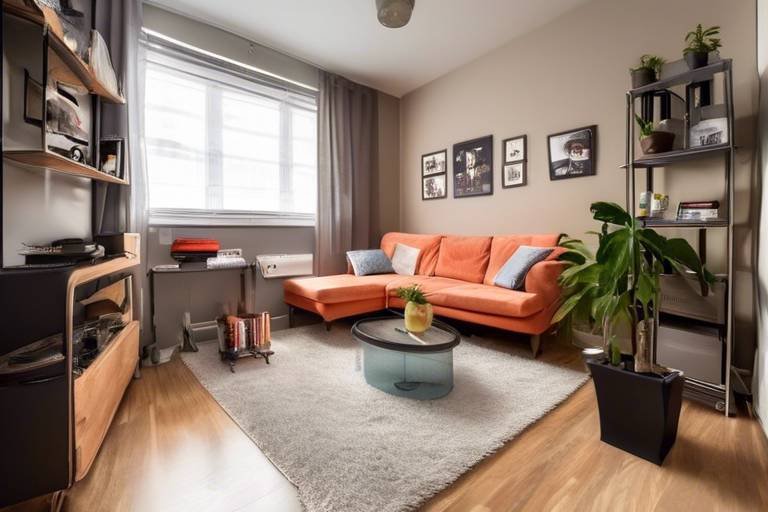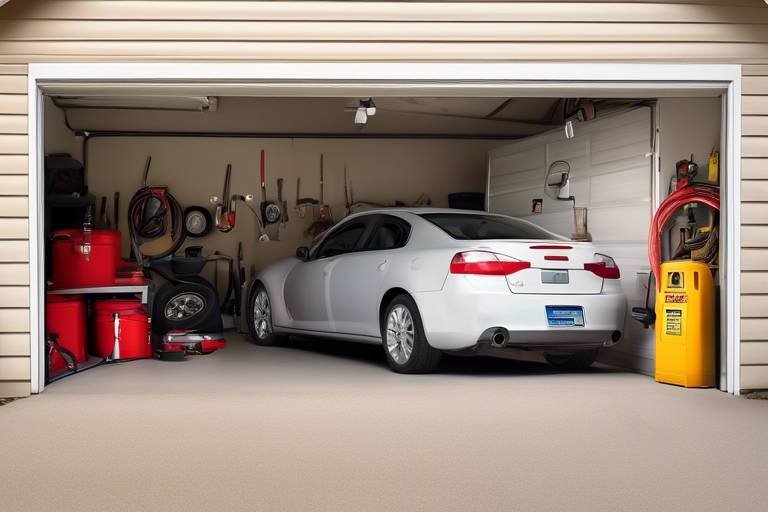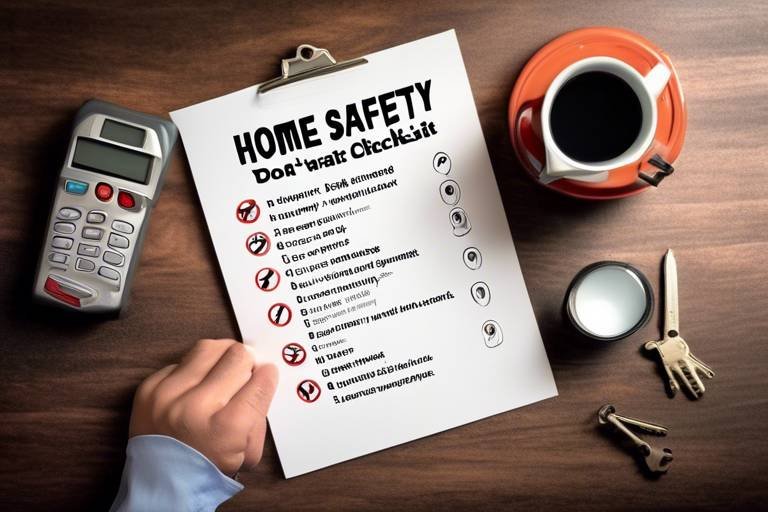Keeping Clutter Under Control for Safety
In our fast-paced lives, clutter can easily accumulate, transforming our homes and workplaces into chaotic environments. It's all too easy to overlook the impact that a disorganized space can have on our safety. Imagine walking through your home and tripping over shoes left haphazardly by the door or struggling to find a fire extinguisher in an emergency because it’s buried under a pile of old magazines. Clutter isn't just an eyesore; it can be a serious safety hazard. This article explores the importance of managing clutter to enhance safety in various environments and provides practical tips and strategies for organizing spaces effectively.
Clutter can pose significant safety hazards, including tripping and fire risks. When spaces are cluttered, it becomes increasingly difficult to navigate them safely. For instance, a cluttered hallway can easily become a trap for unsuspecting feet, leading to falls that could result in injuries. Furthermore, clutter can obstruct pathways to exits, making it challenging to evacuate in emergencies. It's essential to understand these dangers to create a safer environment in homes and workplaces. Just think of clutter as a sneaky villain in your home—always lurking, waiting for the right moment to cause chaos!
Implementing effective decluttering strategies can help maintain a tidy space. One popular technique is the one in, one out rule, which encourages you to remove one item for every new item you bring into your home. This simple practice can significantly promote ongoing organization and reduce clutter accumulation. Additionally, consider setting aside time each week to review your belongings. By regularly assessing what you truly need, you can keep your space manageable and safe.
Establishing a regular decluttering schedule helps ensure that spaces remain organized. Think of it as a routine check-up for your home. Just like you wouldn’t skip your dentist appointment, don’t skip your decluttering sessions! This proactive approach can prevent clutter from becoming overwhelming over time. You might want to set a specific day each month dedicated to decluttering different areas of your home. For example, you could focus on your living room one month, your bedroom the next, and so on. Keeping a calendar can help you stay on track.
Incorporating daily maintenance tips into your routine can help keep clutter at bay. Simple habits can make a significant difference in maintaining an organized environment. For instance, try to spend just 10 minutes each day tidying up common areas. You might be surprised at how much can be accomplished in such a short time! Additionally, make it a habit to put items back in their designated places immediately after use. This small change can prevent clutter from accumulating over time.
Seasonal decluttering allows for a thorough evaluation of belongings. As the seasons change, so do our needs. This practice can help identify items that are no longer needed, further promoting safety and organization. For example, winter gear can be stored away in the spring, making room for summer items. Consider creating a checklist to guide your seasonal decluttering efforts, ensuring you don’t miss anything. Here’s a simple example:
| Season | Items to Declutter |
|---|---|
| Spring | Winter clothes, holiday decorations |
| Summer | Heavy blankets, summer sports equipment |
| Fall | Summer clothes, outdoor furniture |
| Winter | Fall decorations, gardening tools |
Utilizing specific organizing techniques can enhance safety in clutter-prone areas. Strategies like labeling and designated storage can improve accessibility and reduce hazards. For example, labeling storage bins can make it easier to find what you need quickly, minimizing the time spent searching through clutter. Additionally, consider using clear containers so you can see what's inside without having to dig through. This not only saves time but also reduces the risk of items falling or causing accidents.
Designing spaces with safety in mind is crucial for preventing accidents. This involves thoughtful organization and considering how each area is used. For instance, in the kitchen, keep knives and sharp objects stored safely out of reach of children. In living areas, ensure that electrical cords are tucked away to prevent tripping. By prioritizing safety, you can create functional and enjoyable environments.
Each room presents unique challenges regarding clutter and safety. Tailored safety tips for different spaces can help mitigate risks effectively. For example, in the bathroom, ensure that toiletries are stored in cabinets and not left on counters where they can create a slippery surface. In the garage, keep tools organized and off the floor to prevent accidents. Recognizing the specific needs of each room can significantly enhance safety.
Managing clutter is especially important in homes with children. Childproofing strategies combined with clutter control can create a safer living environment for young ones. This includes securing heavy furniture to walls, using safety gates, and keeping hazardous materials out of reach. By implementing these measures, you can significantly reduce the risk of accidents and injuries in your home.
- What are the most common safety hazards associated with clutter? Clutter can cause tripping hazards, obstruct exits, and hide essential safety equipment, increasing the risk of accidents.
- How often should I declutter my home? Establish a routine, such as monthly or seasonally, to keep clutter manageable and ensure safety.
- What are some quick daily decluttering tips? Spend just 10 minutes each day tidying up and always put items back in their designated places after use.

Understanding the Risks of Clutter
Clutter is more than just an eyesore; it can be a **significant safety hazard** lurking in your home or workplace. Imagine walking through your living room, only to trip over a pile of shoes or a stray toy. This scenario is all too common and highlights just how **dangerous clutter can be**. Not only can it lead to **injuries** from falls, but it can also create a breeding ground for accidents and emergencies. Understanding these risks is crucial for creating a safer environment.
One of the primary dangers associated with clutter is the increased risk of **tripping**. According to safety experts, cluttered walkways can contribute to falls, which are among the leading causes of injuries in homes and workplaces. When pathways are obstructed, it becomes difficult to navigate spaces safely. This is particularly concerning for children, the elderly, and individuals with mobility issues. A clutter-free environment can significantly reduce these risks, allowing for safer movement throughout your space.
Additionally, clutter can act as a **fire hazard**. Stacks of newspapers, magazines, and other combustible materials can ignite and spread flames quickly, turning a small fire into a raging inferno in no time. In fact, the National Fire Protection Association (NFPA) states that clutter can obstruct exits and reduce the effectiveness of smoke alarms and fire sprinklers. In an emergency, every second counts, and clutter can hinder your ability to escape safely.
Moreover, clutter can also contribute to **mental stress**. Living or working in a disorganized environment can lead to feelings of anxiety and overwhelm. The constant visual reminders of disarray can distract you from tasks at hand and diminish your overall productivity. It's a vicious cycle: clutter creates stress, and stress can lead to more clutter as you may find it harder to focus on organizing your space.
To better illustrate the risks associated with clutter, consider the following table:
| Risk Factor | Description |
|---|---|
| Tripping Hazards | Obstructed pathways can lead to falls, causing injuries. |
| Fire Risks | Combustible materials can ignite and spread flames quickly. |
| Emergency Access | Cluttered spaces can obstruct exits and hinder escape routes. |
| Mental Stress | Disorganization can lead to anxiety and decreased productivity. |
In summary, the risks of clutter extend beyond mere inconvenience. By understanding these dangers, you can take proactive steps to **manage clutter** effectively. Whether it’s through regular cleaning, creating designated spaces for items, or simply being mindful of what you allow into your home or workspace, a clutter-free environment can promote safety and well-being.

Effective Decluttering Strategies
When it comes to keeping our spaces safe and organized, effective decluttering strategies are the unsung heroes. Imagine walking into a room where everything has its place, and you can easily find what you need without sifting through piles of stuff. Sounds dreamy, right? Well, with a few practical techniques, you can turn that dream into reality. One of the most powerful strategies is the one in, one out rule. This simple concept means that every time you bring something new into your home, you should remove something else. This not only helps keep your space tidy but also encourages mindful purchasing. Think about it: do you really need that new gadget if it means letting go of something you already own?
Another effective strategy is to establish a decluttering schedule. Just like you might set aside time for exercise or grocery shopping, carving out a specific time for decluttering can work wonders. Start small—perhaps dedicate just 10-15 minutes a day to tackle one area of your home. Before you know it, those small efforts will add up, and your space will feel lighter and more inviting. To help you visualize this, consider creating a simple table to track your progress:
| Date | Area Decluttered | Items Removed |
|---|---|---|
| 01/01 | Kitchen Counter | 5 |
| 01/02 | Living Room | 3 |
| 01/03 | Bedroom Closet | 10 |
Incorporating daily maintenance tips into your routine can also be a game changer. Simple habits like putting things back in their designated spots, doing a quick tidy-up before bed, or even setting a timer for a 5-minute clean-up can make a significant difference. It’s all about creating a habit that feels natural and easy. You’d be amazed at how these small actions can help prevent clutter from piling up in the first place.
Don’t forget about the power of seasonal decluttering. Think of it as a spring cleaning ritual, but you can do it at any time of year! This is your chance to evaluate your belongings thoroughly. Ask yourself questions like, “When was the last time I used this?” or “Does this item bring me joy?” If the answer is no, it might be time to let it go. Seasonal decluttering not only helps you identify items that are no longer needed but also refreshes your environment, making it safer and more organized.
Lastly, let’s talk about organizing techniques that can enhance safety in clutter-prone areas. Labeling is a fantastic way to ensure everything is easy to find. Imagine a pantry where every jar and container is clearly labeled. Not only does this make it easier for you to find what you need, but it also reduces the risk of accidents. Designated storage solutions—like bins, baskets, and shelves—can further improve accessibility. When everything has a home, you’re less likely to leave items lying around where they could cause a hazard.
In conclusion, effective decluttering strategies are not just about aesthetics; they're about creating a safe and functional living environment. By implementing these techniques, you can cultivate a space that not only looks good but also feels good to be in. So, are you ready to take the plunge and reclaim your space?
- How often should I declutter? Aim for a regular schedule, such as weekly or monthly, but also listen to your space. If it feels cluttered, it’s time to declutter!
- What should I do with items I no longer need? Consider donating, recycling, or selling items. Always choose a responsible way to dispose of them.
- Can decluttering really improve safety? Absolutely! Reducing clutter minimizes tripping hazards and creates a more organized environment, which can prevent accidents.

one in, one out
This article explores the importance of managing clutter to enhance safety in various environments. It provides practical tips and strategies for organizing spaces effectively.
Clutter can pose significant safety hazards, including tripping and fire risks. Understanding these dangers is essential for creating a safer environment in homes and workplaces.
Implementing effective decluttering strategies can help maintain a tidy space. Techniques such as the rule can promote ongoing organization and reduce clutter accumulation.
The rule is a simple yet powerful strategy to keep your space organized and clutter-free. The concept is straightforward: for every new item you bring into your home, you must remove one existing item. This approach not only helps to prevent clutter from piling up but also encourages mindful purchasing habits. Think of it as a balancing act—each time you add something new, you consciously let go of something old. This practice can be applied to various aspects of life, from clothing and toys to kitchen gadgets and decor.
Imagine walking into a room brimming with unnecessary items. It can feel overwhelming, right? But by adopting the philosophy, you can create a more serene and organized environment. It’s like a breath of fresh air! You’ll find it easier to locate your favorite items, and your space will feel lighter and more inviting.
Here are some practical tips to effectively implement the rule:
- Before making a purchase, ask yourself if you truly need the item.
- Designate a specific spot for items that need to be removed.
- Make it a habit to declutter regularly, perhaps at the end of each month.
- Involve family members in the process to make it a fun and collaborative effort.
By incorporating this rule into your life, you’ll not only reduce clutter but also foster a sense of accomplishment and control over your environment. It’s a small change that can lead to significant improvements in your overall wellbeing.
Establishing a regular decluttering schedule helps ensure that spaces remain organized. This proactive approach can prevent clutter from becoming overwhelming over time.
Incorporating daily maintenance tips into your routine can help keep clutter at bay. Simple habits can make a significant difference in maintaining an organized environment.
Seasonal decluttering allows for a thorough evaluation of belongings. This practice can help identify items that are no longer needed, further promoting safety and organization.
Utilizing specific organizing techniques can enhance safety in clutter-prone areas. Strategies like labeling and designated storage can improve accessibility and reduce hazards.
Designing spaces with safety in mind is crucial for preventing accidents. This section discusses how to create functional and safe environments through thoughtful organization.
Each room presents unique challenges regarding clutter and safety. Tailored safety tips for different spaces can help mitigate risks effectively.
Managing clutter is especially important in homes with children. Childproofing strategies combined with clutter control can create a safer living environment for young ones.
Q: What is the "one in, one out" rule?
A: The "one in, one out" rule means that for every new item you bring into your home, you should remove one existing item to maintain balance and reduce clutter.
Q: How often should I declutter?
A: It's beneficial to declutter regularly, ideally once a month. However, daily maintenance can help keep clutter at bay.
Q: Can I apply this rule to all areas of my life?
A: Absolutely! The "one in, one out" rule can be applied to clothing, toys, kitchen items, and more, making it a versatile strategy for managing clutter.

rule can promote ongoing organization and reduce clutter accumulation.
This article explores the importance of managing clutter to enhance safety in various environments. It provides practical tips and strategies for organizing spaces effectively.
Clutter can pose significant safety hazards, including tripping and fire risks. Understanding these dangers is essential for creating a safer environment in homes and workplaces.
Implementing effective decluttering strategies can help maintain a tidy space. Techniques such as the one in, one out rule can promote ongoing organization and reduce clutter accumulation.
Establishing a regular decluttering schedule helps ensure that spaces remain organized. This proactive approach can prevent clutter from becoming overwhelming over time.
Incorporating daily maintenance tips into your routine can help keep clutter at bay. Simple habits can make a significant difference in maintaining an organized environment.
Seasonal decluttering allows for a thorough evaluation of belongings. This practice can help identify items that are no longer needed, further promoting safety and organization.
Utilizing specific organizing techniques can enhance safety in clutter-prone areas. Strategies like labeling and designated storage can improve accessibility and reduce hazards.
Designing spaces with safety in mind is crucial for preventing accidents. This section discusses how to create functional and safe environments through thoughtful organization.
Each room presents unique challenges regarding clutter and safety. Tailored safety tips for different spaces can help mitigate risks effectively.
Managing clutter is especially important in homes with children. Childproofing strategies combined with clutter control can create a safer living environment for young ones.
The one in, one out rule is a simple yet powerful strategy for keeping clutter at bay. The concept is straightforward: for every new item you bring into your home, you must remove one existing item. This rule not only helps to maintain a balance in the number of possessions you have but also encourages mindful purchasing habits. Have you ever found yourself overwhelmed by the sheer volume of things you own? This rule can be a game-changer!
Think of it this way: if you buy a new pair of shoes, you should consider donating or discarding an old pair. By doing so, you are actively participating in a cycle of organization that prevents accumulation. This practice fosters a culture of intentionality in your shopping habits, making you think twice before adding to your collection. It’s almost like a personal challenge to keep your space clean and organized!
Another benefit of the one in, one out rule is that it can help you develop a better relationship with your belongings. Instead of just acquiring items, you start to appreciate what you already have. You may even find that you have forgotten about some treasures hidden away in the back of your closet!
To make this rule more effective, consider keeping a decluttering checklist. Here’s a simple table to illustrate how you can track your items:
| Item Added | Item Removed | Date |
|---|---|---|
| New Shoes | Old Sneakers | 2023-10-01 |
| New Book | Old Novel | 2023-10-10 |
By maintaining this list, you can visually see the impact of the rule and stay motivated to keep your space clutter-free. Remember, the goal is not just to have less stuff, but to create an environment that feels safe and welcoming. So, the next time you're tempted to buy something new, ask yourself: what will I let go of to make room for this? It’s a small question that can lead to big changes!
- What is the "one in, one out" rule? It is a decluttering strategy where for every new item you bring into your home, you must remove one existing item.
- How can I remember to apply this rule? Keep a decluttering checklist to track items added and removed.
- Is the "one in, one out" rule effective? Yes, it helps maintain organization and encourages mindful shopping habits.
- Can this rule apply to all areas of my life? Absolutely! It can be used for clothing, books, toys, and even digital files.

Creating a Decluttering Schedule
Establishing a decluttering schedule is like setting up a game plan for a big match; it keeps you focused and ready to tackle the mess before it spirals out of control. Imagine walking into your home or workspace and feeling a wave of calm wash over you instead of stress. Sounds dreamy, right? Well, it can be your reality with a little planning and commitment. A decluttering schedule not only helps you stay organized but also makes the process less overwhelming. You wouldn’t run a marathon without training, so why would you dive into decluttering without a solid plan?
Start by determining how often you want to declutter. This could be daily, weekly, or even monthly, depending on your lifestyle and the amount of clutter you typically accumulate. For instance, if you’re someone who tends to gather items quickly, a weekly schedule might be more beneficial. On the other hand, if you’re more of a minimalist, a monthly check-in could suffice. Here’s a simple breakdown:
| Frequency | Best For | Suggested Duration |
|---|---|---|
| Daily | Those who accumulate clutter quickly | 15-30 minutes |
| Weekly | Moderate clutter accumulators | 1 hour |
| Monthly | Minimalists or low-clutter environments | 2-3 hours |
Once you’ve decided on the frequency, it’s essential to set specific goals for each decluttering session. For example, you could focus on a particular room, such as the kitchen or bedroom, or even target specific areas like closets or drawers. By narrowing your focus, you can make the process feel more manageable and less daunting. It’s like eating an elephant—take it one bite at a time!
Additionally, make sure to schedule your decluttering sessions into your calendar, just like any other important appointment. Treat it seriously; after all, a clutter-free environment contributes to a clutter-free mind. You might even want to set reminders on your phone to keep you accountable. And don’t forget to celebrate your victories! After each session, take a moment to appreciate the progress you’ve made. Whether it’s a clean countertop or an organized closet, every little win counts.
Lastly, don’t hesitate to involve others in the process. If you live with family or roommates, encourage them to join in on decluttering days. Not only can it make the task more enjoyable, but it also fosters a sense of teamwork and shared responsibility. You’ll be amazed at how much more you can accomplish together!
In summary, creating a decluttering schedule is a vital step in maintaining an organized and safe environment. By setting a routine and sticking to it, you can significantly reduce clutter and its associated risks. Remember, it’s all about creating a space that feels good to be in—so get started on that schedule today!
- How often should I declutter? It depends on your environment. Daily, weekly, or monthly schedules can all work based on your clutter levels.
- What if I don’t have time to declutter? Even short 15-minute sessions can make a big difference. Just focus on one area at a time.
- Can decluttering really improve safety? Absolutely! Reducing clutter minimizes tripping hazards and helps keep essential items accessible in emergencies.

Daily Maintenance Tips
Keeping clutter at bay is not just a one-time task; it’s a daily commitment that can make a world of difference in your living and working environments. Think of it like brushing your teeth—if you skip it for a few days, the consequences can be pretty unpleasant! By integrating simple daily maintenance tips into your routine, you can cultivate an organized space that feels calm and inviting.
One of the easiest ways to maintain a clutter-free environment is to establish a “5-Minute Rule”. This means dedicating just five minutes each day to tackle small messes. Whether it’s putting away shoes by the door, organizing your workspace, or sorting through mail, those few minutes can prevent chaos from building up. It’s amazing how much you can accomplish when you focus on just a short time frame!
Another effective strategy is to implement a “One In, One Out” policy. For every new item you bring into your home, make it a habit to remove an old item. This practice not only keeps clutter from accumulating but also encourages you to be more mindful of your purchases. It’s like a personal inventory check that ensures you’re surrounded by things that truly add value to your life.
Additionally, consider creating designated spots for items that tend to clutter your space. For instance, set up a small basket or bin for keys, mail, and other essentials right by the door. This simple act can save you time and frustration while keeping your surfaces clear. You might even want to label these spots—after all, a little organization can go a long way!
Finally, don’t underestimate the power of a quick evening tidy-up. Before you go to bed, take just ten minutes to walk through your home and put things back in their designated places. This nightly ritual can help you wake up to a clean slate each day, making it easier to maintain an organized environment. Remember, a clutter-free space is not only visually appealing but also promotes a sense of peace and productivity.
In summary, daily maintenance doesn’t have to be a daunting task. By incorporating these simple habits into your routine, you can keep clutter under control and create a safer, more enjoyable space for yourself and your loved ones.
- How often should I declutter my space?
It’s recommended to declutter regularly, with a focus on daily maintenance and a more thorough evaluation every season. - What should I do with items I no longer need?
Consider donating, recycling, or selling items that are in good condition, and responsibly dispose of anything that is not usable. - Can clutter impact my mental health?
Yes, excessive clutter can lead to feelings of stress and anxiety, making it important to maintain an organized space.

Seasonal Decluttering
Seasonal decluttering is not just a chore; it’s an opportunity to breathe new life into your space! Imagine the feeling of stepping into a room that feels fresh, open, and inviting. Every season brings about changes not only in the weather but also in our lives, and it's the perfect time to assess what we truly need and what can be let go. Think of it as a ritual, much like spring cleaning, where you take stock of your belongings and make conscious decisions about what to keep and what to toss.
As the seasons change, so do our needs. For example, during winter, you might find yourself hoarding extra blankets and holiday decorations. But when spring rolls around, those items can become clutter if they’re not stored properly. By setting aside time each season to declutter, you create a habit that helps maintain a tidy environment. So, how do you go about this? Here are some practical steps to guide you through the process:
- Schedule a Decluttering Day: Pick a specific day each season to focus on decluttering. Mark it on your calendar and treat it like an important appointment.
- Assess Your Belongings: Go through each room and evaluate items. Ask yourself if you’ve used it in the past year. If not, it might be time to say goodbye.
- Organize by Category: Instead of tackling one room at a time, consider organizing your decluttering by category (like clothes, kitchen items, or books). This can help you see how much you really have.
- Donate or Dispose: Create a pile for items you can donate, recycle, or throw away. Remember, one person's trash is another's treasure!
To make the process even smoother, consider creating a seasonal decluttering checklist. This checklist can serve as a roadmap, guiding you through each room and ensuring nothing is overlooked. Here’s a simple example of what that might look like:
| Season | Focus Areas | Action Items |
|---|---|---|
| Spring | Clothes, Garden Tools | Donate unused clothes, clean out the shed |
| Summer | Outdoor Gear, Toys | Sort through toys, check outdoor equipment |
| Fall | Home Decor, Clothing | Store summer items, donate old decor |
| Winter | Holiday Decorations, Winter Wear | Organize decorations, donate unused winter clothes |
Remember, the goal of seasonal decluttering is not just to create a cleaner space; it’s about enhancing your overall well-being. A clutter-free environment can lead to reduced stress and increased productivity. Plus, it’s a great way to make room for new experiences and memories. So, grab a friend or family member to help you tackle the task and make it a fun event!
In conclusion, seasonal decluttering is a powerful tool in maintaining not just a tidy home, but also a clear mind. Embrace the change of seasons as a chance to reassess your belongings and create a safer, more organized living space.
Q: How often should I declutter my home?
A: Ideally, you should aim for seasonal decluttering, but if you feel overwhelmed, monthly check-ins can also help keep clutter at bay.
Q: What should I do with items I no longer need?
A: Consider donating them to local charities, recycling, or even hosting a garage sale to give them a new life.
Q: Can decluttering really improve my safety?
A: Absolutely! Reducing clutter can minimize tripping hazards and create a more organized environment, which is essential for safety.

Organizing Techniques for Safety
When it comes to maintaining a safe and organized environment, implementing effective organizing techniques is essential. Clutter can not only affect the aesthetics of your space but can also lead to serious safety hazards. Imagine walking through your home or office and tripping over items scattered on the floor; it’s a scene that can easily be avoided with a little forethought and planning. One of the best ways to ensure safety is to create a system that promotes organization and accessibility. Here are some strategies to consider:
First and foremost, labeling is a game-changer. By clearly marking storage containers, shelves, and drawers, you can quickly locate what you need without rummaging through a pile of items. This not only saves time but also reduces the risk of accidents. For example, if you have a first aid kit, label it clearly and store it in a designated spot that’s easy to access. In emergencies, every second counts!
Another crucial technique is to establish designated storage areas for frequently used items. By assigning specific places for your belongings, you create a natural flow in your space. For instance, keep all cleaning supplies in one cabinet and tools in another. This practice minimizes the chance of clutter building up in common areas, which can lead to accidents. You might even consider using clear bins or baskets to make items visible and easy to grab.
Additionally, consider the height at which you store items. Heavy or frequently used items should be kept at waist level to avoid the risk of injury when reaching up or bending down. For items that are less frequently used, utilize higher shelves. This way, you’ll keep your space tidy while ensuring that the items you need most are within easy reach.
Moreover, it’s essential to adopt a “one in, one out” philosophy. Whenever you bring something new into your home or workspace, make it a habit to remove something else. This strategy not only helps keep clutter at bay but also encourages mindfulness about what you truly need. Over time, this practice can significantly reduce the buildup of unnecessary items, contributing to a safer environment.
Lastly, don’t underestimate the power of regular maintenance. Setting aside a few minutes each day to tidy up can make a world of difference. Whether it’s putting away shoes that have been left by the door or organizing paperwork on your desk, these small actions prevent clutter from accumulating. You could even create a simple checklist to ensure that you’re consistently addressing areas prone to clutter.
In conclusion, organizing techniques for safety are not just about aesthetics; they are about creating a functional and hazard-free environment. By implementing these strategies, you can significantly reduce the risks associated with clutter and promote a safer, more enjoyable space for everyone.
- What are the main safety hazards associated with clutter?
Clutter can lead to tripping hazards, obstructed pathways, and increased fire risks, making it essential to keep spaces organized. - How often should I declutter my space?
It’s advisable to declutter regularly, such as monthly or seasonally, to prevent clutter from becoming overwhelming. - What are some simple daily maintenance tips?
Incorporate habits like putting items back after use, setting aside time for quick clean-ups, and regularly assessing your belongings. - How can I childproof my home while managing clutter?
Use storage solutions that are out of reach for children, label items clearly, and regularly evaluate which items can be safely stored away.

Creating Safe Spaces
Designing spaces with safety in mind is not just a good idea; it’s essential for preventing accidents and ensuring peace of mind. Think about it: when you walk into a room, does it feel open and inviting or cluttered and chaotic? The latter can lead to trips, falls, and even more serious accidents. To create a safe environment, you need to consider both the physical layout and the organization of items within that space. A well-thought-out room can transform a chaotic atmosphere into a haven of safety.
One of the first steps in creating safe spaces is to assess the specific needs of each area. For instance, a living room should be designed for comfort but also for functionality. You might want to arrange furniture to allow for easy movement, ensuring that pathways are clear. Consider using non-slip rugs to prevent falls, especially if you have young children or elderly family members. Moreover, keeping frequently used items within reach can minimize the risk of accidents caused by stretching or climbing.
In kitchens, safety takes on a different form. Sharp objects, hot surfaces, and slippery floors all pose unique risks. To combat these hazards, you can implement several strategies. First, use childproof locks on cabinets containing hazardous materials. Next, ensure that all knives and sharp tools are stored safely away from the edges of countertops. Additionally, consider using a magnetic knife strip to keep knives off the counter, thus reducing the risk of accidental cuts.
Bathrooms are another area where safety should be a priority. Wet floors can be a recipe for disaster, so it’s wise to invest in water-resistant mats and non-slip bath mats. Furthermore, installing grab bars near the shower and toilet can provide much-needed support for those who may struggle with balance. Remember, a little preparation can go a long way in preventing accidents.
When it comes to bedrooms, the focus should be on creating a relaxing yet safe environment. Ensure that pathways to the bed and bathroom are clear, and consider using soft lighting to illuminate these areas at night. This can help prevent nighttime trips and falls. Additionally, keeping clutter off the floor and utilizing storage solutions like under-bed boxes can help maintain a tidy space.
To summarize, creating safe spaces involves a combination of thoughtful organization and strategic design. Here are some key elements to consider:
- Assess the specific needs of each room.
- Keep pathways clear to prevent tripping hazards.
- Utilize safety features like childproof locks and grab bars.
- Invest in non-slip mats and rugs.
- Use soft lighting to enhance visibility in high-risk areas.
By taking these steps, you can transform your home into a sanctuary of safety. But remember, safety is an ongoing process. Regularly reassess your spaces and make adjustments as needed. Your home should evolve with the needs of its inhabitants, ensuring that safety remains a priority.
Q: How often should I reassess the safety of my home?
A: It's a good idea to reassess your home's safety at least twice a year, or whenever there are significant changes in your household, such as new children or elderly family members moving in.
Q: What are some quick fixes for a cluttered space?
A: Start by implementing the "one in, one out" rule, utilize storage bins, and designate specific areas for frequently used items to keep things organized.
Q: Are there specific products that can help with safety in the home?
A: Yes, consider investing in non-slip mats, childproof locks, grab bars, and soft lighting options to enhance safety in various areas of your home.

Room-Specific Safety Tips
When it comes to keeping our homes safe, it's essential to recognize that each room has its own unique set of challenges. By understanding these specific risks, we can implement tailored strategies to reduce clutter and enhance safety. For instance, in the kitchen, where sharp objects and hot surfaces abound, it's crucial to keep countertops clear and utensils stored securely. Imagine trying to cook a meal while dodging a stack of dirty dishes or a pile of mismatched pots and pans—it's a recipe for disaster!
Moving into the living room, this space often becomes a catch-all for various items, from magazines to toys. To avoid tripping hazards, consider creating designated storage areas for items that tend to clutter the space. Use decorative baskets or bins to keep things organized and out of the way. You might even find that a tidy living room is more inviting for guests—who doesn’t love a space that feels open and welcoming?
In the bedroom, clutter can affect not only safety but also your overall well-being. A disorganized space can lead to stress and anxiety, making it harder to unwind at the end of a long day. To combat this, try to keep surfaces like nightstands and dressers free from unnecessary items. Consider a minimalist approach to your decor; fewer objects mean fewer distractions and a more peaceful atmosphere.
Bathrooms can be particularly hazardous due to wet surfaces and small spaces. Ensure that toiletries and cleaning supplies are stored safely out of reach of children. Installing non-slip mats can also help prevent falls, turning your bathroom into a sanctuary rather than a slip-and-slide. A clear floor space can make a world of difference when you’re trying to navigate in a hurry!
Lastly, let’s not forget about the garage or basement, areas notorious for becoming cluttered with tools and seasonal items. These spaces can quickly turn into a chaotic mess, presenting numerous safety risks. Implementing a clear labeling system for storage bins can help you find what you need without digging through piles of stuff. Plus, consider hanging tools on walls or using pegboards to keep things off the floor. This not only organizes your space but also keeps potential hazards out of the way.
In summary, by focusing on room-specific safety tips, we can significantly reduce clutter and create safer living environments. Each room has its own personality and needs, and adapting our strategies accordingly will help us maintain a home that is both organized and secure. So, which room will you tackle first? Remember, every little bit counts!
Q: How often should I declutter each room?
A: It's generally a good idea to declutter each room at least once a month. However, high-traffic areas like the kitchen and living room may require more frequent attention.
Q: What are some quick tips for maintaining a clutter-free space?
A: Implement the "one in, one out" rule, establish a daily tidy-up routine, and designate specific storage areas for items to keep clutter at bay.
Q: How can I safely store hazardous items in my home?
A: Always store hazardous items, such as cleaning supplies and sharp tools, out of reach of children. Use locked cabinets or high shelves to keep them safe.

Childproofing and Clutter Control
When it comes to creating a safe environment for children, childproofing and clutter control go hand in hand. Imagine your living space as a playground where every corner invites exploration, but without the right precautions, it can also become a hazard zone. Clutter not only makes it difficult to find essential items but also increases the risk of accidents. Toys strewn across the floor, books piled high, and miscellaneous items left out can lead to trips and falls. So, how do we tackle this issue effectively?
First and foremost, it’s essential to establish a designated play area for your children. This area should be kept clear of any unnecessary clutter and equipped with storage solutions like bins and baskets. By having a specific spot for toys, you can encourage children to return items after use, promoting responsibility and organization from an early age. Plus, it makes cleanup a breeze! Consider using clear containers so that kids can see what’s inside, making it easier for them to find and put away their toys.
Next, let’s talk about the importance of visibility. Keeping items that are frequently used within reach while storing away potentially dangerous objects is crucial. For instance, you might want to keep cleaning supplies and sharp objects in high cabinets or locked drawers. This not only minimizes clutter in easily accessible areas but also ensures that children are kept away from items that could pose a risk. A good rule of thumb is to regularly assess the environment and remove any items that are no longer needed or that could be hazardous.
Additionally, consider implementing a “one in, one out” rule for toys and other belongings. This means that for every new item that comes into the house, an old one must be donated or discarded. This practice helps maintain a manageable amount of belongings and prevents accumulation, which can lead to chaos. You’d be surprised how much easier it is to keep things organized when you limit the number of toys and items in circulation.
Moreover, it’s vital to involve your children in the decluttering process. Teach them about the importance of keeping their space tidy and how it contributes to their safety. Use this opportunity to explain the dangers of clutter in a way they can understand. For instance, you could say, “If we keep our toys on the floor, someone might trip and get hurt.” This not only makes them aware of the risks but also empowers them to take part in keeping their environment safe.
Lastly, remember that childproofing is an ongoing process. As children grow, their needs and the potential hazards in your home will change. Regularly revisit your clutter control strategies and adjust them as necessary. By doing so, you’ll create a dynamic space that evolves with your family while maintaining safety as a top priority.
- What are the best storage solutions for children's toys?
Clear bins, labeled boxes, and shelving units are excellent for organizing toys and keeping them accessible while minimizing clutter. - How can I encourage my child to help with cleaning up?
Make it fun! Turn cleanup into a game or set a timer to see how quickly they can put their toys away. - What should I do with toys that my child no longer plays with?
Consider donating them to charity or passing them on to friends or family. This helps promote a sense of giving while reducing clutter.
Frequently Asked Questions
- What are the main safety risks associated with clutter?
Clutter can lead to various safety hazards, including tripping hazards and fire risks. When items are strewn about, they can obstruct pathways, making it easy to trip and fall. Additionally, excessive clutter can accumulate dust and debris, which can be a fire hazard if it comes into contact with heat sources.
- How can I start decluttering my space effectively?
Begin by setting aside a specific time to tackle one area at a time. Use the "one in, one out" rule to prevent future clutter accumulation. This means for every new item you bring into your space, you should remove one. This simple strategy can significantly help in maintaining an organized environment.
- What daily habits can help me maintain a clutter-free space?
Incorporating small daily habits can work wonders! Make it a routine to put things back in their designated places after use, and set aside a few minutes each day to clear surfaces. Additionally, create a habit of evaluating items regularly to see if they are still needed, and consider donating or discarding things that no longer serve a purpose.
- How often should I conduct seasonal decluttering?
Seasonal decluttering is a fantastic practice, and doing it at least four times a year is recommended. This allows you to assess your belongings with fresh eyes and identify items that may have been overlooked. It’s a great opportunity to refresh your space and ensure that it remains both organized and safe.
- What organizing techniques can enhance safety in my home?
Utilizing techniques like labeling storage bins and creating designated areas for specific items can greatly improve safety. When everything has a place, it reduces the chances of items being left out and causing hazards. Additionally, consider using clear containers so you can easily see what’s inside without having to dig through clutter.
- How can I create a safe space for children while managing clutter?
Childproofing is key! Ensure that dangerous items are out of reach and use storage solutions that are easy for kids to access but also safe. Regularly evaluate toys and items to remove those that are broken or no longer used. This not only keeps the space organized but also ensures that your little ones are safe from potential hazards.
- What are some room-specific safety tips I should consider?
Different rooms have unique challenges. For example, in the kitchen, keep sharp objects and cleaning supplies stored away safely. In living areas, ensure that walkways are clear and that furniture is arranged to prevent accidents. Assess each room and tailor your clutter control strategies accordingly to enhance safety.



















